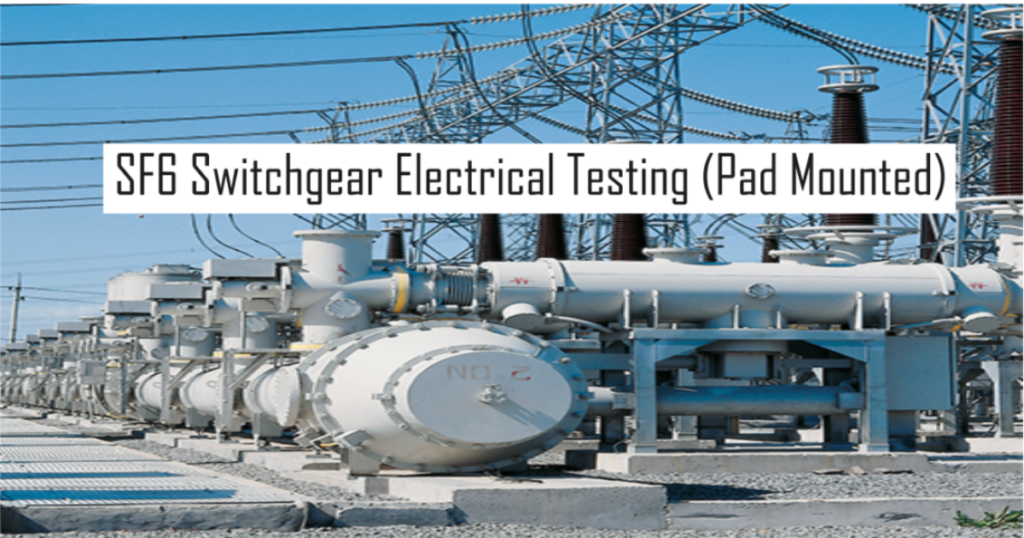Electrical testing of SF6 switchgear is essential to ensure the safety, reliability, and performance of the equipment. SF6 (sulfur hexafluoride) switchgear is commonly used in high voltage applications for its excellent insulating and arc quenching properties.

Read Also: SF6 Circuit Breaker: Working Principle, Types, Applications, Technical Issues
Mechanical Inspection of SF6 Switchgear (Pad-Mounted).
Mechanical inspection of SF6 switchgear, particularly pad-mounted switchgear, is important to ensure the equipment’s structural integrity, proper functioning, and safety.
- Inspect for physical damage and compare nameplate data with plans and specifications.
- Perform mechanical operations tests in accordance with manufacturer’s instructions.
- Verify proper operation grounding switch.
- Check interlocks for correct operation.
- Check for positive gas pressure in SF-6 switches, verify no leaks.
- Verify use of proper cable termination’s (Elastimold 600 Amp with voltage test point) and phasing.
- Verify hardware is properly installed and torqued.
- Grounding installed.
- Switches have exterior coating in accordance with standards requirements for area location.
- Verify current rating and sizing of current transformers and that they are properly installed.
- Verify internal arc over pressure exhaust venting is properly installed.
By conducting a thorough mechanical inspection of SF6 switchgear, including pad-mounted switchgear, you can identify and address any mechanical issues or deficiencies promptly, ensuring the equipment’s reliable operation and longevity. Regular inspections should be performed according to manufacturer recommendations, industry standards, and regulatory requirements to maintain compliance and minimize the risk of equipment failure or accidents.
Electrical Testing of SF6 Switchgear (Pad-Mounted).
Electrical testing of SF6 switchgear, particularly pad-mounted switchgear, is essential to ensure the equipment’s electrical integrity, safety, and proper functioning. Here are some key electrical tests commonly conducted on SF6 pad-mounted switchgear:
- Perform insulation resistance test on each pole, phase to phase and phase to ground for one (1) minute.
- Perform A.C. or D.C. high potential test on each pole to ground and pole to pole with the switch in the closed position. High potential test voltages shall be applied in accordance with vendors recommended values.
- Perform contact resistance test across each interrupter. Contact resistance shall be determined in micro-ohms. Any value exceeding 150 micro-ohms or any values which deviate from adjacent poles or similar switches by more than 20 percent (20%) should be investigated.
- Verify continuity of ground connection between breaker and ground grid via current injection.
- Perform trip tests for circuit breakers.
- Verify settings and operation of protective relays.
Nameplate Data of SF6 Switchgear (Pad-Mounted)
| Switch No. | |
| Manufacturer | |
| Model No. | |
| Serial No. | |
| Rated Voltage | |
| Rated Current |
High Potential Test of SF-6 Switchgear (Pad-Mounted)
| Breaker Closed | Current AC or DC | Breaker Open | Current AC or DC |
| Phase A to Gnd. | Phase A line to load. | ||
| Phase B to Gnd. | Phase B line to load. | ||
| Phase C to Gnd. | Phase C line to load. | ||
| Phase A to B. | |||
| Phase A to C. | |||
| Phase B to C. |
Test Data SF-6 Switchgear (Pad-Mounted)
| Electrical Mechanical tests | Manufacturer’s recommended test values. | PHASE A | PHASE B | PHASE C |
| Insulation Resistance. | Breaker closed Phase to ground Megohms_____ | Breaker closed Phase to ground Megohms______ | Breaker closed Phase to ground Megohms______ | |
| Contact Resistance. | Breaker closed Micro-Ohms _______ | Breaker closed Micro-ohms _______ | Breaker closed Micro-ohms _________ | |
| Interrupter AC High Potential. | PASS_____ FAIL _____ | PASS _____ FAIL _____ | PASS ______ FAIL ______ |